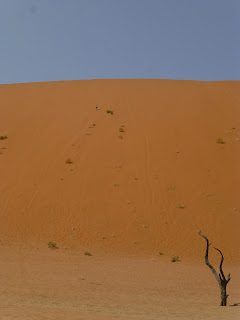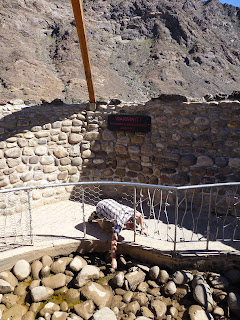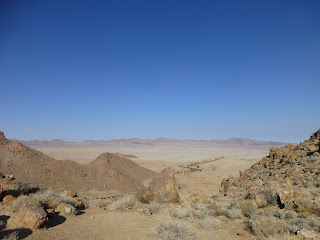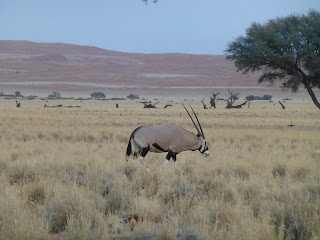Wednesday 4 September
We’re driving to Fish River Canyon
today. It’s only a couple of hours away,
so we decide to detour and take the scenic route. It’s worth it. A winding dirt road weaves us across near
desert landscapes with not another car to be seen.
It’s just about lunchtime when we pass the
Canon Roadhouse just outside Fish River Canyon.
It’s beautifully done up with vintage cars and various bits of
memorabilia. We decide to treat
ourselves to lunch, simply because it’s the most interesting place we’ve seen
since flying in.
Nick goes for a gut-busting lasagna while I
stick with a toastie (Namibia is a meat-lovers heaven, but not the best for
veggies). We’re too full for puds but I
get a slice of Amarula cheesecake to take away and we head for the canyon.
Fish River Canyon is the second largest
canyon in the world. We’ve assumed
there’s a lot to do here, so we’ve booked 2 nights at the nearby campsite,
Hobas. The campsite is pleasant enough
but we head straight out to the main lookout point. The canyon is vast – stretching out in an
otherwise empty landscape.
There’s a 5-day hiking trail that runs
through the middle of the canyon that is open from April to September, but
apart from that, day and ‘leisure’ hikes into the canyon are strictly
forbidden. It’s understandable, but it
does mean there’s not much to do except take the canyon in from the various
viewpoints. We do take a short ‘hike’
from one viewpoint to the next and then tackle the 4x4…ish drive (as the sign
says) to some other viewpoints.
It’s a stony, bumpy ride, but for almost
all the way we have the canyon entirely to ourselves as we wind our way along
the canyon rim. I could imagine the
Grand Canyon being like this 50 or 100 years ago.
At the end point we stop for our cheesecake
(and some more views) before heading back to make camp.
Thursday 5 September
We have a little problem today: we kind of
maxed out the Fish River Canyon yesterday, so although we’ve booked in for 2
nights, we’re short of things to do today.
We decide to drive on to the Ai Ais.
This is a separate section of the park with a resort, which promises
natural hot springs and the like. It’s a
bit of a drive down the road and when we arrive I check in at reception to find
out what there is to do. ‘Nothing much’
is the reply, and I’ve got to appreciate the honesty.
We’re at the ‘shallow’ end of the canyon
here and we’re allowed to walk in along the riverbed. We take the opportunity, but the soft river
sand makes it hard going. We’re not
particularly kitted up for any serious walking, so we keep it to a short
stroll, enjoying the local baboon troops along the way.
There is indeed a swimming pool, and a
small natural spring that you can burn your hand in, but not bathe in.
Within an hour or so we’ve exhausted the
possibilities here as well. We’re headed
for Luderitz on the coast and rather than head back to Hobas to kill the rest
of the day we decide to keep heading south. A scenic route along the banks of the Orange
River will soon put us back on the road to Luderitz.
It’s a good decision because of all the
scenic driving we’ve done so far this is some of the best. Once
again there is not another car to be seen on the road. This time we’re driving through proper
moonscape surroundings as the sat nav tells us to turn right and drive 25km
through the middle of a desert. In the
distance a glowing pink mountain range rises up ahead of us.
At midday we reach the mighty Orange River,
which (here at least) forms the border between South Africa and Namibia. Our little road hugs the rocks as it skims
past the broad expanse of water.
Sometime in the early afternoon we run out
of river and hit a tarred (!) road. From
here the road is straight as an arrow up to Aus, where we’ve decided to stop
for the night. There’s not a lot in Aus
and our campsite of choice happens to be full.
They offer us a cabin for the night and we take it – purely because they
have free wifi in the lobby and we’re desperate to get a bit of internet time. We have a few beers in the lobby whilst we
catch up online, then head to our cabin.
We’re not entirely sure what we’ve gotten ourselves into, especially as
our cabin is a good 7km or so away from reception. We let ourselves in to find 2 dorm style
rooms rammed with bunkbeds. Eek! We race back to reception to demand a refund,
only to be reassured that we have exclusive use of the whole cabin for the
night. Ah, that changes things. As we head back we can really appreciate our
surroundings. Our cabin is in a little
valley (literally) miles from anything.
The scenery is out of this world and we
pass gemsbok, ostrich and wild horses on the drive in. A short walk up the hill provides wonderful
views.
Despite the bunkbed sleeping arrangement
it’s still high luxury for us to have toilets, showers and a sink on site,
never mind the numerous fireplaces, the fridge and the gas stove.
We light a fire outside and spend an
evening under stars that seem to be shining just for us, before retiring to our
‘4-poster’ bed.
Janet adds: I came to bed to find that Nick
(aka Captain Romance) had built a lovely fire in our room but silly me (a
little tipsy from 2 giant bottles of Windhoek beer whilst interneting) had a
carbon monoxide freak-out and had to go and sleep in the other room, torch
gripped firmly in hand to ward off whatever lurked in the dark L
Friday 6 September
It’s a bright, beautiful morning with
achingly blue skies. Once we’re packed
and ready to go we take a half hour or so to walk up one of the hills where
we’re rewarded with near endless views.
We’re only an hour or so from Luderitz so we’ve
got a bit of time to sidetrack and get a little closer to the Namib feral
horses. Er, but maybe not that close…
No one is quiet sure where they originate
from, though there are numerous theories.
One thing that is fairly certain is that they’re thoroughbred horses
that at some stage went wild. Wherever
they came from they are now uniquely adapted for desert life. It’s quite a sight to see them mingling with
the oryx and ostriches with the dunes for a backdrop.
Luderitz is a charming seaside town with a
strong German influence. We stop briefly
at tourist information to grab a map and some info and then set about taking
care of some practicalities. First stop
is the laundry where we drop off a giant load of dirties. While that’s being done we have some lunch and
explore the colourful buildings in town.
We’ve still got time for a quick drive up
to the beach and some Flamingo viewing.
Back in town we grab our washing, pick up
some groceries and head for the campsite.
We’re a little worried, as the guidebook has described it as
‘aggravatingly windy’. When we arrive,
we’re pleasantly surprised. The campsite
is on a little peninsula (Shark Island) that juts out to sea, giving fantastic
360 views. There’s hardly even a breeze
and the sun is shining. It’s empty when
we arrive and so we have the pick of the bunch.
We choose a site that looks straight out onto the water and kick back
to enjoy the sunset.
After dark we opt for a change of pace and turn our car into a home cinema for the evening.
Janet adds: I guess we were a little too
smug. By the time we went to bed the
wind had picked up something fierce and the tent was blowing every which
way. We batten it down as best we can
and prepare ourselves for a restless night.
Saturday 7 September
It’s not a great night’s sleep for either
of us and it doesn’t help that the morning is grey, cold, windy and damp with
fog. We slowly drag ourselves up and get
going.
We’ve booked a tour of Kolmanskop today –
an abandoned mining town just outside Luderitz.
The dunes are slowly reclaiming this ghost
town.
Not surprising: almost as soon as we arrive
we have sand in our teeth, our eyes, our ears, everywhere. We spend a bit of time poking around the
museum before the tour starts.
Kolmanskop was founded in the early 20th century by CDM
(Consolidated Diamond Mines) as a headquarters after diamonds were found in the
area. It was a well-serviced and wealthy
town complete with hospital (that contained the country’s first x-ray machine),
butchery, bakery, ice factory etc. The tour takes us around these key
buildings, some of which have been partly restored. Unfortunately for Kolmanskop bigger diamonds
were found further south and the mines moved their operations to
Oranjemund. By the mid-50s Kolmanskop
was abandoned. Once the tour ends the
fun starts. What we’ve really come here
for is the chance to poke around the buildings that haven’t been restored.
This being Namibia, health & safety is
a little on the lax side and we’re free to wander in and out of houses at will
– and even clamber up the rickety staircases. It’s fantastically atmospheric with sand
pouring in through open doorways and cracked windows, even filling bathtubs.
Once we’ve taken about a thousand pictures
we’re ready to go. We’re taking a scenic
drive around the Luderitz peninsula this afternoon. This is diamond country and we’re right on
the border of the Sperrgebiet – the ‘Forbidden Zone’ – this diamond mining
concession has been off limits to the public for pretty much 100 years. As it’s name suggests, you’re forbidden from
even accidentally straying into this land. There are numerous road signs
reminding you of this and the guidebook warns of over-zealous armed guards with
too much time on their hands. We stop to
eat our picnic lunch on the beach (without having crossed the magic forbidden
line) and within minutes a security van was along to check us out.
That aside it’s a lovely drive, taking in
flamingos, a seal colony, a penguin colony and Diaz Point, where we stop for
tea and cake and yet more flamingos.
By mid-afternoon we’re ready to head back
to town. The wind is still howling and
we were hoping for a night on the town tonight, so we’re not relishing another
night on the campsite. We decide to sack
it off and book into a hotel instead. I
barely make it through the door before collapsing on the bed (real bed!) for a
nap.
It’s a Saturday night and we’d hoped for a
little buzz around town, but it’s dead quiet.
I spot the local yacht club and for some reason (too much time spent in
the South Pacific…) decide it might be a happening place. Instead it turns out to be a time warp back
to the 1970s, where we choke down beers through a haze of cigarette smoke
whilst watching the locals play darts.
We grab pizzas (difficult to make those on
a bbq) at a nearby restaurant and head back to max out our sleep time.
Sunday 8 September
What a pleasure it is to wake up to a damp,
grey morning when you’re in a comfy, warm bed!
Even better – the shower is just next-door and someone downstairs is
making us breakfast. We’d best not get
used to this.
Once we’ve soaked up the luxury we pack up,
get stocked up and hit the road. The
first hour or so goes swimmingly and then the sat nav decides to cut a cheeky
corner off. Before we know it we’re
bouncing along tiny tracks that really don’t count as roads (how they’re on the
sat nav I don’t know).
After a good half hour or so we finally
spot in the distance the road we want to be on.
The track we’re on practically disappears but with salvation in sight we
push on, only to find our way blocked by a fence.
We try another detour, but this time a
triple padlocked gate blocks our way. Oh
dear. At last, after one final detour,
we find an unlocked gate that puts us back on the road.
From here it’s fairly easy (and scenic of
course) driving. By mid-afternoon we’re
at the campsite where we’re stopping for the night. It’s right next door to Duwisib Castle, so of
course we have to go and take a look. If
you’re wondering what a castle is doing in the middle of nowhere, Namibia, so
is everyone else. A (possibly somewhat
eccentric) German built it in 1909.
Although it’s certainly castle shaped it’s not particularly castle sized
and it doesn’t take us long to tour through it.
After that it’s time to sit back and relax
in the campsite we have all to ourselves.
Monday 9 September
It’s a sunny, warm morning today and we
have a leisurely breakfast before packing up and heading off. We’re on a bumpy road today and the
landscape around us has turned a bit hilly.
There’s even the odd patch of vegetation, with a whole lot of
nothingness in-between.
We’re cutting through the Namib-Naukluft park,
so there’s plenty of wildlife to keep an eye out for – ostriches, springboks
and oryx make sudden dashes across the road.
By 11.30 we’ve arrived at Sesriem, which is
to be our base for the next couple of days while we explore the
Sossusvlei. This is the Namibia you
always see in pictures: towering red sand dunes stretching out into blue skies.
We get checked in and then start the hour
or so drive up to the Sossusvlei. The
dunes start creeping in around us, getting closer and closer to the road. Finally one is within reach – Dune 45 – and
we stop here to eat our picnic and snap a few pics.
From there it’s another 20km or so up to
the Sossusvlei – the last 4km being on a very sandy track: you’ve just got to
keep going and hope you don’t get stuck.
At first glance the Sossusvlei is a little disappointing with the dunes
in the distance rather than towering above you.
A short walk out into the desert changes everything. Almost before we know it dunes are rising up
on every side, with patches of dry, cracked earth in between. Our destination is dead vlei – a flat, dry
pan filled with dead trees and encircled by dunes. It’s a beautiful spot.
We decide to climb a nearby dune to get a
better perspective – easier said than done.
It’s like the world’s best/worst stair master.
 |
| I'm creeping my way up there! |
The climb just about finishes us both off,
but the views from the top are worth it.
The walk back down and to our car is a
little easier. It’s time for us to drive
back and set up camp. We’ve got a lovely
big campsite under a huge tree, with a few Sprinbok as eye candy.
Janet adds: the only problem with our
lovely tree is it’s huge, low branches.
We’ve both clocked ourselves on the head badly already – and no doubt
that won’t be the only time for either of us.
Tuesday 10 September
The dunes are supposed to be at their most
vivid shortly after sunrise and one of the main advantages of camping in the
park is that you’re allowed a little bit of a head start on the drive to get up
into the dunes.
We’re more than a little worried that
sunrise is going to be packed with people and over-touristy, but since we’re
here we decide to give it a go anyway.
We’re up in the dark to get our tent packed down and we manage to slip
through the gates minutes after they’ve opened.
The sun is still up long before we’re at the dunes, but there’s some
cloud cover this morning, which buys us a little time. We’ve decided to head for the ‘hidden vlei’
this morning. We’re told it’s ‘the’
place to be, so we’re expecting it to be rammed with people. We couldn’t be more wrong. It’s a 2km hike into the desert (and this
being Namibia, they’re more than happy to just let you wander off into the
desert at will).
When
we reach the vlei there’s not another soul in sight. We’ve got it all to ourselves as the sun
finally pops out and lights up one side of the mighty dunes.
We enjoy the solitude, snapping off
hundreds of pics. We’re tempted into
going and trying our luck at dead vlei again, figuring the early light will be
better than yesterday’s afternoon light.
It’s soon clear that this is where all the people are. What we had all to ourselves yesterday
afternoon is overrun with people this morning.
It’s still a beautiful spot, but much nicer when you have it all to
yourself.
We’re back at the campsite by late morning
and have a bit of a relax in the shade.
At lunchtime we make some sandwiches and then drive to Sesriem
Canyon. It’s the other attraction in
this area and can’t help being overshadowed by the Sossuvlei, so we’re not
expecting much. It turns out to be a
beautiful, narrow canyon carved out through the rock.
We spend some time hiking through it in
both directions and then brave the hot walk back to the car.
By the time we get back to camp we’re ready
for a cool off in the pool. The water is
icy, but so good. We laze away the rest
of the afternoon, watching the sun make a rather spectacular descent, until
it’s fire time.
Wednesday 11 September
I wake up a little after sunrise this morning to find an oryx grazing just outside our campsite. We've seen oryx everyday since arriving in Namibia, but they are beautiful creatures and it's still a thrill to see them this close.
We get packed up and start
heading for the coast. It’s about 330km
away on gravel roads. All the roads have
been good so far, so we’ve just assumed they’d stay that way. Not today.
The road is bone-rattlingly, teeth-clenchingly corrugated for mile after
mile. There is also a lot more traffic
than we’ve experienced thus far. After
half an hour we’re both asking if we’re nearly there yet. There is (of course) some spectacular scenery
along the way, but we’re struggling to appreciate it.
Finally, when we’re not too far out of
Walvis Bay, it smooths out a little and we can unclench our teeth. Walvis Bay is Namibia’s only port and is a
busy, work-a-day town. Despite the
industry it’s a nice looking town with wide, well-maintained streets and green
spaces. The afternoon is moving on and
we slip into a café just before it closes to get some lunch. After that, we take a short drive along the
lagoon that fronts the town. This is a
flamingo hotspot and there are plenty of flamingos about. We’re both getting a little flamingo obsessed
I think.
Swakopmund, where we’re staying for the
next couple of nights, is only half an hour or so up the coast. Camping is no fun in cities, especially cold,
coastal ones, so we (and I mean Nick) had the foresight to book into a hotel. We get checked in and abuse the free wifi for
a bit before heading down to the beach.
We stop to get a sundowner in the Tug – an
old tugboat that’s been turned into a restaurant with breathtaking views out to
sea.
There’s a chilly wind blowing in off the
even chillier sea and we’re wrapped up in our thermals, but that doesn’t deter
the group of youngsters frolicking and shrieking in the waves. Yes, it does make me feel old.
We head up the street to another pub
(inside this time) and then pop round the corner for some food. Nick has found a place that serves zebra
(when it’s in season, and apparently this is zebra season). Oh dear.
Janet adds: Loved it when Nick asked the
waitress what zebra was like and whether it tasted anything like horse. She looked at him like he was mad and said
‘I’ve never eaten horse!’.
Thursday 12 September
We spend today wandering around town,
taking care of some practicalities (laundry, always laundry) and enjoying some
of Swakopmund’s premier attractions. The
main attraction is the town’s setting: nestled in between a dune field and the
Atlantic Ocean.
We detour (read: I drag Nick into) the
Kristall Galerie which houses an impressive collection of crystals but is, in
the end, not much more than a glorified jewelry shop.
Later on we visit the Living Desert Snake
Park. It’s a great opportunity to see
these beautiful and (thankfully) elusive creatures up close, but I’m not sure
we needed the reminder of how many snakes there are that can kill us as we
wander over to the ablution blocks half asleep in the dark. It’s not all snakes. There are a few other critters, including
this guy.
In the evening we take ourselves out for
some food. This time we (Nick) manage to
avoid the exotic game and stick to lasagna (beef for Nick, spinach for me). The location is somewhat exotic though: the restaurant
is situated in a working lighthouse.
After a grand night on the town with
starters, a few drinks and mains we’re pleasantly surprised to be set back a
mere £25.













































No comments:
Post a Comment